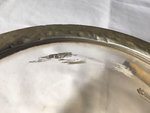Hi. Newbie here. Have had this glass bubble for the past 20+ years. A vet once told me he believed it was a light cover from a WWII bomber. There are no attachment doohickies or other elements that would seem to allow this to "lock" into place or screw in somewhere. Metal rim feels like aluminum, globe is roughly 1/2" thick. Google search has turned up NADA. Any help would be greatly appreciated. Thanks in advance.











